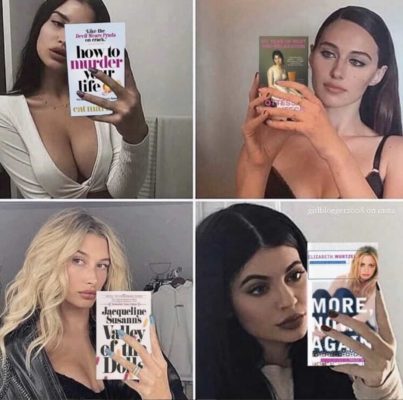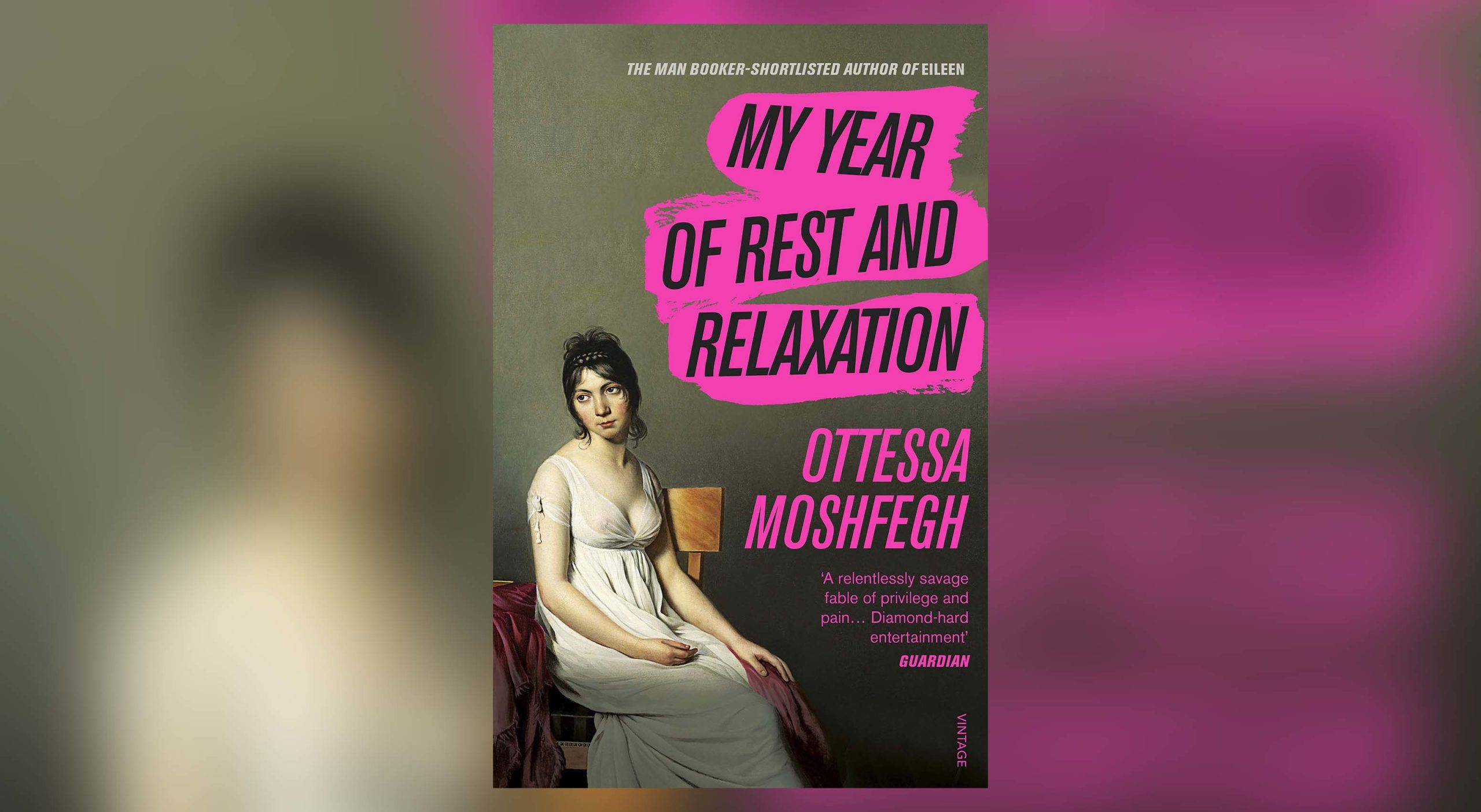My Year of… Restlessness and anxiety?
My Year of Rest and Relaxation is millennial literary phenom Ottessa Moshfegh’s second novel. Her other works expose and gently pull apart the same themes: feelings of deep, seemingly incurable loneliness, usually from a female perspective. Her works feature women in incredibly unique situations but somehow manage to make them accessible and universally applicable. My Year of Rest and Relaxation was shortlisted for the Man Booker prize, making a sizable splash in the literary world back in 2018. None of this explains the gigantic online obsession that it has amassed in the last six months (we can probably thank BookTok for that).
In short, My Year of Rest and Relaxation is a work of early 2000s historical fiction that focuses on an unnamed, twenty-something Columbia art history graduate living and working in a prosperous post-y2k New York City. She has it all: a great job at an art gallery, a paid-for apartment, social and cultural capital due to her wealth and beauty. Despite all of this, she is depressed. She struggles to cope with the death of her parents, something she hasn’t acknowledged (and she’ll spend the whole book working through this). Her only escape from the tortuous ease and mundanity are Whoopi Goldberg movies on VHS and deep, dreamless sleep. She sleeps on her lunch breaks at the art gallery and gets fired for it. Realizing that her natural circadian rhythm doesn’t allow her to sleep enough, she visits a quack doctor to get prescribed various pills that will make her body shut down against its will. Her increasingly disturbing visits to her psychiatrist with a screw loose result in prescriptions piling onto prescriptions. Not since the doctor in Requiem for a Dream has there been a more incompetent physician. The book focuses on her increasingly extreme and complicated attempts to spend as much time as possible asleep. She decides on a year of sleep: this is the eponymous year of rest and relaxation, which she describes as “saving her life”.
Her social network is barebones, composed of her self-made corporate friend Reva, a dress size four (six if she’s bloated) gym rat envious of our narrator in every way. Her two male companions are her fuck buddies (the precariously masculine Wall Street asshole Trevor) and an ambiguous romantic interest (the modern artist Ping Xi). The narrator doesn’t care about any of these people:, they are simply side characters in her story. The world revolves around her, and everyone else is nothing but white noise at the edges of her narrative.
Even the coldest, most cynical person will empathically cringe at some of our main character’s acidic internal monologues. In a particularly difficult scene, she enters her friend Reva’s apartment and cruelly tears it apart. Reva struggles with bulimia, a medical condition which our protagonist sees not as a serious disorder but a moral shortcoming. This constant criticism of Reva never really abates: she criticizes her for the way she drinks tequila and diet mountain dew, for her dress sense, for her bodily insecurities and eating disorder, for her obsessive exercise. Reva is the only person to come visit the narrator during her depressive sleep episodes, but the narrator always acts annoyed, brushing her off. This toxic friend dynamic shifts in the third act, but leaves us wondering if it is too late. Without spoiling the ending, everything is resolved and neatly wrapped up, for better or for worse. The book ends with such genius it’s almost frustrating. (And for the record, I did cry.)
My Year’s unnamed protagonist is unlikable — a move that I think is deliberate. We sympathize with her: we don’t empathize. She has just enough distasteful traits to make us love her and hate simultaneously. When her Columbia sorority sisters are cold and unfeeling after her parent’s death, we feel bad. In a way, us as the reader are the sorority sisters: we feel bad, but we also gloat a bit at her struggle. Finally, she’s being knocked down a peg. But we soon feel worse and worse, as our protagonist’s volatile family dynamic and history are slowly unveiled throughout the novel via disturbing waking nightmares and breakdowns.
Why has the book become so popular now? To make a reach, it’s the combination of escapism into the novel and our societal escapism into anything but our current reality. It’s as if there is a meta escapism: the scores of readers want to escape to the world that the narrator is trying to escape from. I really can’t disagree with them: who wouldn’t want to be a hot blonde trust fund baby working at a trendy art gallery in NYC? But to think this is to miss the point completely. The book is a cautionary tale of an emotional and temporal dissatisfaction of a materially satisfied life In several instances, the narrator admits to not even liking designer clothes; she just did what was expected of her. In a flashback, one of her university professors makes fun of her Miu Miu boots, and she thinks nothing of it. She just continued to purchase designer boots. It isn’t until she undergoes her extended drug-induced haze that she begins to question her buying choices. Who was it that said that the unexamined life is not worth living?
All of this complicated vaguely anti-capitalist messaging resulted in a peak of Twitter popularity this summer. I saw murmurings on literary Twitter in the springtime, some YouTube reviews appearing. By June, it had entered into other Twitterspheres, the various esoteric communities I’m a part of absolutely eating it up. These aren’t communities known for their literary knowledge, mind you. The book has become a mere symbol of itself, a pale representation twisted by pubescent girls reading it, missing the point, and unabashedly admiring the narrator’s wealthy WASP background, her Columbia education, her good looks, her designer wardrobe. The painting on the cover has become inextricably associated with the book itself. This idealization ignores the deep emptiness the narrator feels, her deep sense of listlessness, her exhaustion with the boring excess of NYC high culture. Of course, there is no ‘wrong’ way to interpret art, and most of the memes are self-criticizing and referential in a typical 2021 fashion. This has generated a wave of memes and edits that center around pretty girls holding books. My Year of Rest and Relaxation has made its way in the literature-for-pretty-girls canon alongside the Virgin Suicides, Lolita, and The Secret History.

Memes are most easily spread on Instagram, an entirely visual medium with a user base that’s the target audience for the book. The narrator’s exhaustion is something nearly universal. Don’t we all want to detach from society for a bit? To not worry about money, or a job, or friends and family? Aren’t we all exhausted? The sudden popularity of the book can be reasonably attributed to the climate of self-care that has emerged alongside the coronavirus pandemic: a year of rest relaxation was kind of what we were promised. When COVID extended beyond that first month, it became clear we would be spending an indefinite period inside our homes. This soon became an unattainable goal. The stress of online school for students, the constant stream of emails and zoom meetings for the employed, the continued work and long hours for the members of the service industry, who never got a break. On top of all of this is the constant social media pressure to be productive. Your Instagram explore page constantly asks you what you’ve accomplished during the lockdowns. Did you write a book? Did you lose weight? Did you establish multiple streams of income? No! I just wanted to relax, goddamnit!
The book is great — I’ve read both Death in Her Hands and McGlue, and this was by far my favourite Moshfegh work — but the hype around it is inseparable from the content or quality of the book itself. It’s not a new book, so most bookstores I called didn’t have it in stock, instead carrying her more recent book, Death in Her Hands. I eventually got it special ordered, the hype overtaking me. I needed to own it. It sits on my shelf at home, proudly declaring me an active participant in social media hype. I recommend you participate too.





